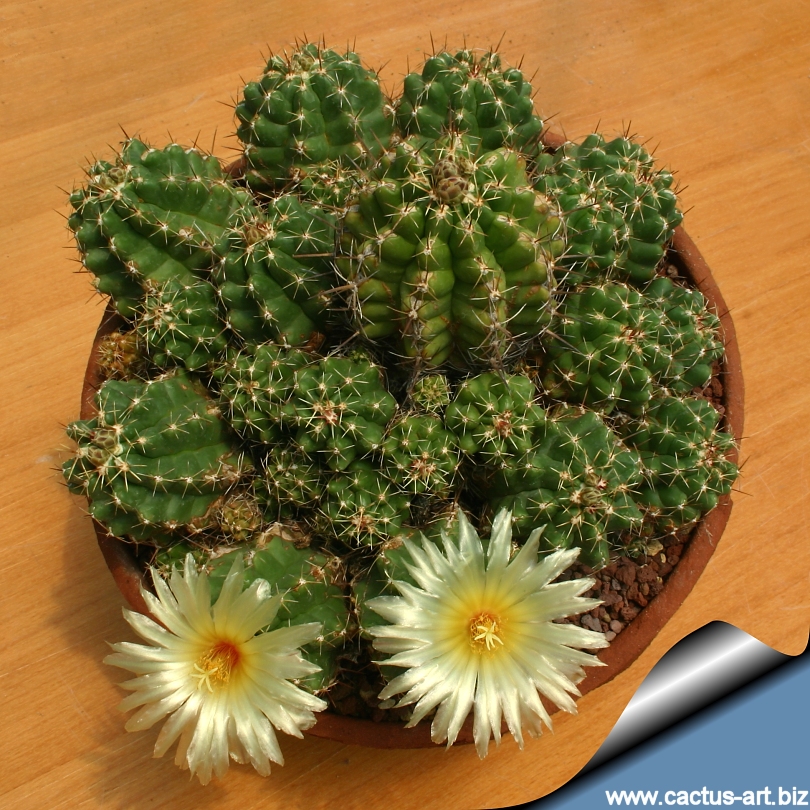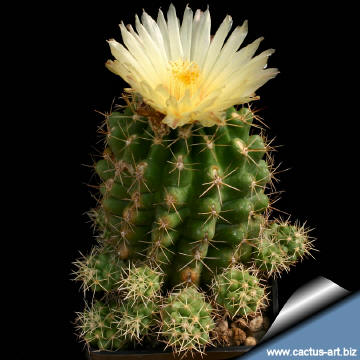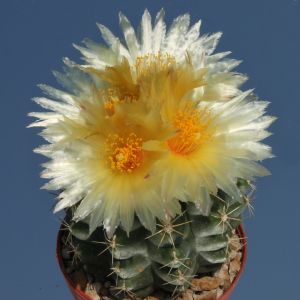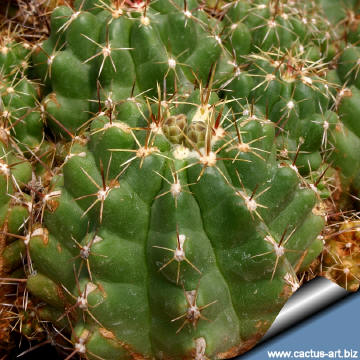|
Accestisce facilmente formando grandi cespi composti da decine di teste. Fiori gialli, raro.
Family: Cactaceae (Cactus Family)
Scientific name: Thelocactus leucacanthus ssp. leucacanthus (Zucc. ex Pfeiffer ) Britton & Rose.
Published in: The Cactaceae; descriptions and illustrations of plants of the cactus family 4: 8-9, f. 7, 1923
Conservation status: Listed in CITES Appendix II
Origin: Mexico (The ssp. leucacanthus comes from Hidalgo while the ssp. schmollii comes from Queretaro.)
Habitat: Grows in the xerophytic scrublands in limestone rich substrata at an altitude of about 1200-1990 m.
Etymology: Lecacanthus derives fro the Greek leukos (white) and akantha (spine)
Synonyms:
- Ferocactus leucacanthus
- Thelocactus porrectus
- Thelocactus sanchezmejoradae
- Thelocactus sanchezmejoradai
- Thelocactus leucacanthus var. sanchezmejoradae
- Thelocactus leucacanthus var. porrectus
- Echinocactus porrectus
- Cereus maelenii
- Thelocactus leucacanthus var. ehrenbergii
- Echinocactus ehrenbergii
- Echinocactus leucacanthus
- Cereus tuberosus
- Thelocactus ehrenbergii
 Thelocactus leucacanthus Thelocactus leucacanthus
This species forms large clumps of spiny stems with star-shaped spines.
|
 |
Description: Cushion forming cactus. Forms large groups up to 80cm in diameter.
Stem: Green globular or elonged 8- 15 cm tall, 3-6 cm in diameter.
Ribs: 7-14 straight or spiralling.
Tubercles: Conical with rounded tip, 8-11 mm tall,. 10-14 mm wide.
Areoles: Elonged 6 x 3 mm wide, spaced 4-6 mm. Positioned on the top of the tubercle and furnished with nectariferous glands.
Central spines: 0-1, upright, yellowish-white to almost black, 9-50 mm long.
Radial spines: 6-20 short (5-7 mm long) star-shapes moderately recurved, yellowish-white becoming reddish to greyish as they age.
Flowers: Diurnal, funnel-shaped 2,5-5,2 cm long, 2-4,5 cm in diameter, the colour varies from pale yellow to pink depending on the variety and clone. They are produced on the apex of the youngest tubercles and are furnished by scales. Filament yellowish-green, anthers yellow, style pale magenta with 5-6 stigmatic lobes.
Blooming season: The Thelocactus leucacanthus blooms at the end of spring. The flowers last for several days but close every night.
Fruit: Furnished of scales, green to yellowish sub spherical 6-9 mm in diameter that dry at maturity. Dehisces basally and conserve the floral remnant.
Seed: Pyriform black, 1,4-2 mm long, 1-1,8 mm in diameter.
The subspecies 'leucacanthus' has yellow flowers, and the subspecies 'schmollii' has violet to carmine red flowers, both live at lower altitudes, and ssp. schmollii with large tubercles rather than distinct ribs, looks more like a Coryphantha than it does a Thelocactus.
Cultivation: It is a summer grower species easy to cultivate. Water regularly from Spring to Autumn, but do not overwater, can become too elongated if compost is too rich. Requires full sun or light shade and careful watering to keep plant compact with strong coloured spines. Needs good drainage and very porous potting mix, In Winter, keep dry.
Reproduction: From seed or by cuttings as it produces many basal plantlets.
|



 Thelocactus leucacanthus
Thelocactus leucacanthus